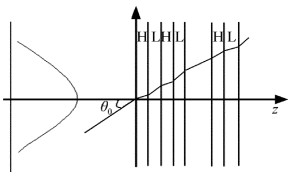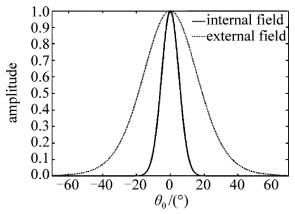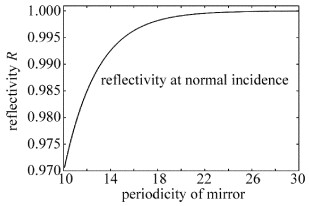HTML
-
垂直腔半导体光器件具备体积小、功耗低、易于集成等优点,历来受到人们的重视[1-5]。其中,垂直腔半导体光放大器(vertical cavity semiconductor optical amplifier,VCSOA)可以看作是偏置在阈值电流以下(但非常接近)工作的激光器,它可以对入射光进行法布里-珀罗(Fabry-Perot, F-P)放大。前期的研究工作表明,作为光放大器,入射端面反射率对VCSOA的增益以及饱和输出特性有重要影响;应用于慢光时,VCSOA的时延带宽积也与入射端面反射率密切相关。因此在VCSOA设计制作中,准确控制其端面反射率,对于优化VCSOA在不同应用中的性能,是至关重要的[6-10]。
VCSOA中由多层高、低折射率交替的膜堆构成的分布布喇格反射器(distributed Bragg reflector,DBR)来提供光反馈,DBR膜堆结构决定了它的端面反射率。正入射条件下,DBR的反射率是易于计算的。但是,VCSOA腔长很短,入射到DBR上的很大一部分光是不满足正入射条件的,这样正入射条件下计算出的DBR反射率必然有偏差。所以,考虑到VCSOA内部光场分布特点,本文中将结合角谱理论和传输矩阵法来计算分析VCSOA中DBR的等效反射率。从VCSOA内部发出的光,入射到DBR上的角频谱近似服从高斯分布,首先采用传输矩阵法计算各个角频谱分量的等效反射系数,然后对反射的角频谱进行傅里叶逆变换得到反射光场分布。入射光场和反射光场一旦确定, 就可以利用它们之间的耦合关系计算出等效反射率。
计算结果表明,与只考虑正入射情况相比,修正的DBR等效反射率小了2%~4%。对于激光器而言,因为制作时可以增加DBR膜堆的层数以确保高的反射率,降低器件阈值电流,所以正入射计算误差并未引起人们的重视。但是对于放大器而言,出发点不再是降低器件阈值电流,而需要根据不同应用需求,优化设计端面反射率的大小,这样,准确计算膜堆层数对DBR等效反射率的影响就成为前提条件,这正是作者工作的动机和出发点[11-16]。
-
VCSOA的微腔结构的形式是用高折射率层与有源区相邻,再接以低折射率层组成一个HL周期,两侧分别连接m个和n个周期,最后再接一个H层结束,形成(HL)(HL)…(HL)H结构,这种结构简称为HLH结构[17],如图 1所示。
根据光学薄膜原理,多层介质膜第j层的特征矩阵Mj为[18]:
式中,λ是光波波长,dj为该层厚度,nj为该层折射率,θj为入射角度,i为虚数单位, δj=2π/(λnjdjcosθj),ηj对于p偏振时为ηj=nj/cosθj,对于s偏振是ηj=njcosθj。本文中所用的薄膜厚度为1/4波长, 即dj=λ/4。整个DBR的传输矩阵M为:
式中,m表示DBR结构周期。
式中,k+1层为衬底层,B和C分别为膜层和基板的组合特征矩阵。
于是可以得到DBR多层介质膜的等效导纳Y=C/B, 则膜系的Fresnel反射系数r和反射率R为:
式中,*表示共轭。利用这种方法,可以得到注入光的DBR等效反射率。
在VCSOA中有源腔内,光以一定的角度θ0入射到DBR面上[17], 如图 2所示。
入射场角频谱Fi(s)可以认为服从标准高斯分布:
式中,A为高斯函数的幅值,s=sinθ0,θ0是入射角。该分布的半峰全宽(full width at half maxima,FWHM)σ定义为幅度降低一半时对应的s,即${s_{{\rm{FWHM}}}} = \sqrt {2\ln 2} {\sigma _0} $=1.1774σ0, σ0为正态分布的方差。则对应θ0的θFWHM=2arcsin(sFHWM)= 2arcsin(1.1774σ0)。
对(6)式进行傅里叶逆变换, 得到入射光场分布:
根据菲涅耳反射定律,反射场的角频谱Fref(s)为:
式中,r(θ0)为菲涅耳反射系数。
对Fref(s)进行傅里叶逆变换, 得到z=0处的反射场Eref(x)。
-
光波在DBR处被反射,同时一部分向自由空间输出, 如图 3所示。
输出光场的角频谱Fo(s)为:
式中,t(θ0)为菲涅耳透射系数。
从参考文献[16]中知道,一般半导体激光器的出光孔径为2μm~17μm时,远场扩散角度的半值谱宽为30°~7°。而对于垂直腔激光放大器,出光孔径更小,为1μm左右。远场扩散角的半值谱宽为40°左右。图 4中给出了远场扩散角的半值谱宽为38°时的内外角频谱分布图,纵坐标为相对值。由点线模拟结果可以知道,此时腔内角频谱Fi(s)的半值谱宽θFWHM=12°,σ0=0.09。拟合出来的结果与韩国公司生产的型号为RayCan RC32xxx1-Fd的光器件完全一致。
1.1. 反射率的计算
1.2. 半值谱宽θFHWM的判定
-
表 1为各膜层折射率。图 5中给出了在正入射的情况下,利用传输矩阵法计算出的GaAs/AlAs结构的DBR反射率随周期数变化曲线。从图中可以看出, 随着DBR结构周期数的增加,腔反射率逐渐增加。VCSOA的一个DBR作为出光面,既要保证有一定的腔反射率用于形成谐振,又要使激射波长有一定的腔透射率用于形成激光输出;而另一个面作为反射面,主要考虑增大反射率从而使腔内有更高的增益。所以一般VCSOA的双层DBR结构并不对称。当结构周期大于25时,中心激射波长处的反射率接近1,并且基本已经不再随周期增大而改变,所以VCSOA反射面的DBR周期一般选取为25左右。而出光面的周期则既要考虑谐振,又要考虑激射波长,因而需要适当地选取。通常此类VCSOA产品出光面的DBR周期选为13。
VCSOA refractive index DBR(GaAs) 3.45 DBR(AlAs) 2.89 active area (InAs0.5P0.5) 3.36 active area (In0.8Ga0.2P) 3.30 active area (InP) 3.17 base area (GaAs) 3.45 Table 1. Refractive index
图 6中给出了考虑光场分布时,采用角频谱分析法计算出的反射率随着DBR结构周期的变化关系曲线。从计算结果可以看出,VCSOA中DBR等效反射率和光场分布有一定的关系。在一定的光场分布下,等效反射率的变化趋势和正入射时利用传输矩阵法的结果是一致的。等效反射率都随着结构周期增加而增加,且当DBR结构周期大于25时基本不再增长。在以上的分析中,作者已经提到本文中VCSOA中入射到DBR上角频谱分布的半值谱宽θFWHM一般在12°左右。图 7中给出了两者的对比情况。可以看出,当腔内角频谱分布的半值谱宽θFWHM为12°时,在同一结构周期下,VCSOA中DBR的等效放射率要比直接利用正入射的模型计算小2%~4%。这在分析VCSOA工作特性时是至关重要的。图 6中还给出了θFWHM为8°和16°时,等效反射率随结构周期的变化情况。

Figure 7. Relationship between reflectivity and periodicity of DBR under θFWHM=12° and normal incidence
图 8中给出了DBR等效反射率随光场分布的关系。在同一结构周期下,等效反射率在正入射θFWHM=0°时最大,并随着θFWHM变大而逐渐降低。从图中看出, 当光场分布比较集中(θFWHM < 8°)时,等效反射率和正入射时相当。(结构周期为13时,等效反射率为0.985)。此时的光相当于正入射到DBR上,光场失谐不大,对等效反射率影响较小。随着半值谱宽增加,入射场和反射场的失谐程度越大,等效反射率越低。考虑光场分布的影响后,同一结构周期的等效反射率降低了2%~4%。当周期为13、且θFWHM=12°时,等效反射率R=0.97。当腔内光场分布更不集中的情况下,等效反射率更低。
-
本文中利用角频谱分析法,结合传输矩阵计算了VCSOA中DBR的等效反射率。等效反射率随着结构周期增加而变大,但是当周期大于25时基本不再变化。分析了等效反射率和光场分布的关系。在同一结构周期下,考虑光场分布时的等效反射率和正入射变化趋势相同,但是要小2%~4%。等效反射率随着半值谱宽θFWHM增大而减小。这为准确计算膜堆层数对DBR等效反射率的影响提供了理论指导,可进一步优化VCSOA的工作性能,例如降低阈值、优化增益带宽积等。

 Map
Map











 DownLoad:
DownLoad:






